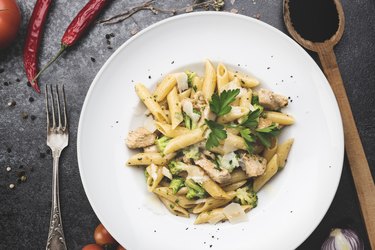
Penne pasta is similar to the other types of pasta when it comes to calories and nutrition. If you're trying to figure out how healthy or unhealthy your love for pasta is, here's what you need to know about penne pasta's nutrition profile.
Penne is a cylindrical-shaped pasta that is usually about 2 inches long. The word "penne" means "pens" or "quills" in Italian, according to the National Pasta Association. The diagonal cuts at the ends of the cylindrical pasta pieces resemble the nibs of fountain pens or quills.
Video of the Day
Video of the Day
The smooth type of penne is known as "penne mostaccioli," which means "small mustaches," whereas the ridged type of penne is known as "penne rigate." Nutritionally speaking, they are both the same — ridged penne is said to absorb more flavor, per the National Pasta Association.
Penne Pasta Nutrition
Penne pasta's nutrition profile is similar to other types of pasta. The calories in cooked penne pasta mostly come from carbs, which make up 84 percent of the calories, per the USDA. Each serving of penne has about 9 calories from fat. Protein makes up 23 of the calories in a serving of penne pasta.
A serving of penne pasta is 2 ounces of dry pasta which makes 1 cup of cooked pasta, per Barilla, a pasta manufacturer. This amount of plain penne will give you:
- Calories: 200
- Total fat: 1 g
- Saturated fat: 0 g
- Trans fat: 0 g
- Cholesterol: 0 mg
- Sodium: 0 mg
- Total carbs: 42 g
- Dietary fiber: 2 g
- Sugar: 2 g
- Protein: 7 g
Penne Pasta Macros
- Total fat: A cup of penne pasta has 1 gram of total fat, with no saturated fat or trans fat.
- Carbohydrates: A cup of penne pasta has 42 grams of carbs, which includes 2 grams of fiber and 2 grams of sugar.
- Protein: A cup of penne pasta has 7 grams of protein.
Pasta is part of the grain group of foods, which should make up roughly one-fifth of your meals, according to the USDA 2020-2025 Dietary Guidelines for Americans,
The recommended amount of grains for a 2,000-calorie diet is 6 ounces of grains per day, of which at least half should be from whole grains.
Vitamins, Minerals and Other Micronutrients
You'll get a dose of B vitamins from eating penne pasta, as well as some iron. A cup of penne pasta serves up:
- Thiamin (B1): 47% Daily Value (DV)
- Folate (B9): 30% DV
- Riboflavin (B2): 20% DV
- Niacin (B3): 19% DV
- Iron: 10% DV
Tip
As part of a healthy eating plan, the USDA recommends replacing refined grains in your diet like penne pasta with whole grains, such as whole-grain penne, because you get more fiber and nutrition for the same amount of calories.
Is Penne Pasta Healthy?
According to the USDA guidelines, most of the carbs in your diet should come from whole grains rather than refined grains like regular penne pasta, which is made from refined white flour.
Whole-grain penne pasta boasts more fiber and nutrients than refined flour varieties, and it can be a part of a healthy diet depending on how you serve it.
The USDA guidelines note that foods like pasta, burgers, tacos and pizzas that contain a lot of cheese and meat tend to have a lot of saturated fat and calories.
Replacing cheesy, buttery and creamy sauces with herbs, spices and nutritious oils can help you take in less saturated fat, according to the Cleveland Clinic. This will also help you build pasta recipes that are low in calories.
Adding lots of veggies and protein like fish or chicken to pasta can help add some nutrition to your pasta dish, and healthy fats like extra-virgin olive oil can help make the dish more filling, according to Tufts University's School of Nutrition and Policy.
- National Pasta Association: Penne
- National Pasta Association: Penne Rigate
- Cleveland Clinic: “Fat: What You Need to Know”
- Tufts University’s School of Nutrition and Policy: “Healthy Meals With Pasta”
- USDA: 2020-2025 Dietary Guidelines for Americans
- MyFoodData: Barilla Penne Enriched Macaroni Product